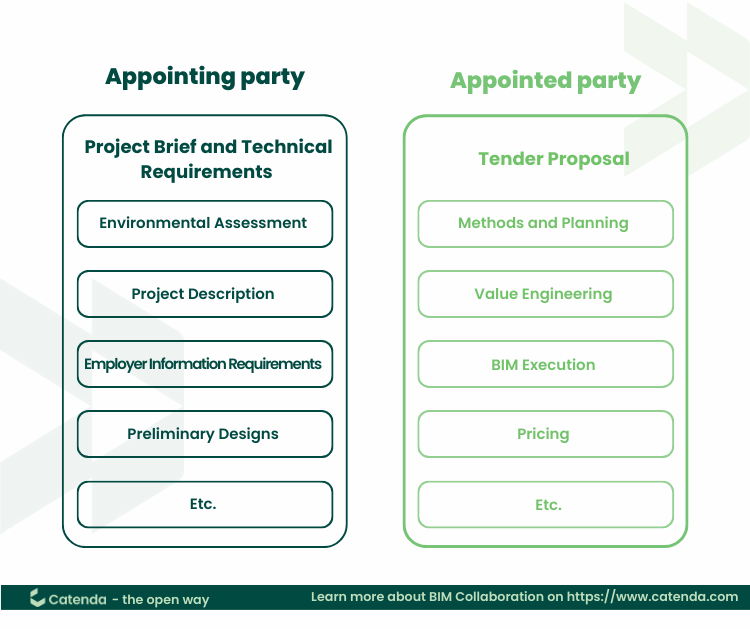In the construction industry acronyms are used extensively when it comes to recurrent, and yet important, documents. The more regulations, project management processes or other rules come to light, the more documentation must be produced by the project team. The Building Information Modeling (BIM) methodology has brought many new acronyms, including the EIR (Employer Information Requirements) and the BEP (BIM Execution Plan). People often confuse them, as BIM has not landed on every project nor in every company yet. So what is the difference between the two?
The origin
Instead of jumping straight into the subject, it is interesting to go back in time and see where this originated.
In 1969, 5 persons in the US decided that it would be beneficial to any professional to lay ground rules for managing projects: the Project Management Institute (PMI) was born.
Over the years, the PMI has set out key concepts and processes to manage and plan a project. These processes have been divided into 5 groups:
(1) Initiating
(2) Planning
(3) Executing
(4) Monitoring & Controlling
(5) Closing
In order for each stakeholder to have a common understanding of the project, and because there is a large amount of shared data, it is important to draft documents that detail each of the above processes.
Over the years, new technologies were introduced as well. The technologies created new layers of communication: we moved from meetings and letters to phone calls and emails, to live chats and real-time changes to deliverables. This made it necessary to adapt the management of project information.
On the other side of the pond at this time, the BS1192:1990 defined processes and methods for information management. In the 1990s, this was still mainly 2D information, but the third edition of the BS1192 in 2007 introduced 3D model-based information (which later became the ISO 19650). Like the PMBOK Guide, the British Standards set foundations for the scope, quality and resources of information management through the production of the Employer Information Requirements (EIR) and the BIM Execution Plan (BEP).
Learn more about ISO 19650 here.
What are their purposes ?
When an owner or a real estate developer starts a project, they draft a Project Brief and Technical requirements with the help of some specialists. In these documents they describe what they await from the asset and what they are trying to achieve. They also provide crucial information about the environmental conditions and rules, regulations and certifications applicable to that project, so companies can price the execution of the project. In addition to pricing, each company drafts a response to the client’s briefing, called a “Tender Proposal”.
Upon entering into a contract with the appointed company, the Project Brief, Technical Requirements and Tender Proposal become contractual documents. Both parties are legally bound by them.
If the appointing party has decided to run the project using the BIM methodology, they will have to draft an Exchange Information Requirements (previously called Employer Information Requirements in the BS1192), which will become part of the Technical Requirements and thus become a contractual document.
Similarly to the Tender Proposal, the appointed company will provide a BIM Execution Plan as part of their offer.

In broad and simple terms, the Exchange Information Requirements document details the following topics:
- The reasons why the Client has decided to use BIM (to obtain a model for the FM phase, to manage data across the asset portfolio, to increase productivity and efficiency during the design phase, etc.)
- Responsibility for the management, production, collection and control of the information exchanged
- Technical aspects (format of deliverables, etc.)
The BIM Execution Plan is the response to the EIR from the company responding to the tender (a contractor, an architect or an engineering firm). It details:
- How they will produce what is necessary for the Client
- Definition of the exact responsibility matrix
- The detailed technical aspect (software used, data drops, planning, etc.)
Why are they often mixed up ?
As mentioned in the introduction, BIM Methodology is not widely used in the industry. Most projects are conducted without a common space to share and store data. Information management is still very fragmented, with each company using its own servers and site file cabinets. So the first reason would be the lack of experience.
It could be that this is their first BIM managed operation and therefore they have never heard about EIR, BEP, etc.
Or it may be that this is not their first time, but they did not grasp the various concepts because they were explained in a complex manner.
Another explanation would be the terms themselves: in English, the two documents have very different names and people can easily understand which phase of a project they refer to (Requirements for early design and expression of need, Execution as in the construction phase). However, in French for example, the two documents have very similar titles “Charte BIM” and “Convention BIM”. So if a project team wants to get into the BIM Methodology, it must be supported by good specialists.
Going into more details (Pre- and Post BEP ?!)
Here is an important quote from the PMBOK Guide “Due to the potential for change, the development of the project management plan is an iterative activity and is progressively elaborated throughout the project lifecycle.[…] Progressive elaboration allows a project team to define work and manage it to a greater level of detail as the project evolves”.
This is also true for the information management plan. While an EIR is rarely updated during the course of a project due to its contractual value, this could be the case when new stakeholders join the project (such as the Facility Manager) or new technologies are implemented in the Client’s company (like a BOS – Building Operating System).
It is more common for BEPs for firms to write Pre-contract BEPs when responding to a two-stage tender on a Design & Build project, with broad responses to the client’s EIR, to demonstrate their BIM knowledge. Once appointed, the company will need to further detail their BEP, leading to the Post-Contract BEP.
The latter is written from the Pre-BEP and includes more details, such as the actual project planning and the information delivery plan. As the project evolves (meaning new parties, new constraints, etc.), this document will be constantly updated to incorporate those changes. The Post-BEP is more of a working document than a contractual one, and will mature as the project progresses.
The difference between the EIR and the BEP is who wrote them, for what purpose and when. One way to keep these two documents from getting mixed up is to designate competent stakeholders to help you develop your knowledge while delivering your project. And in the meantime, if you are looking for a support document to draft your BEP, you can always download our template here.
Fun fact: “Developing or acquiring a new or modified information system (hardware or software)” is on the list of the “project examples” in a PMBOK.
Bianca Giorsetti, Director France at Catenda.
—
Sources:
https://www.pmi.org/about/learn-about-pmi/history-of-pmi
https://www.designingbuildings.co.uk/wiki/BS_1192
PMBOK Guide Fifth Edition




